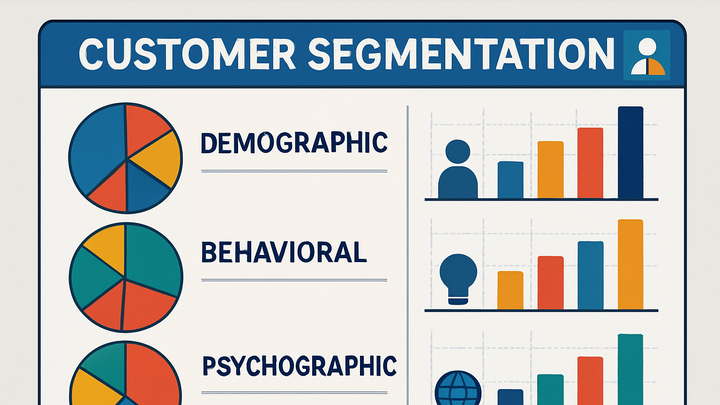Published on 2025-06-28T13:43:11Z
What is Customer Segmentation? Examples for Customer Segmentation.
Customer Segmentation in analytics is the practice of dividing a broad customer base into smaller groups based on shared characteristics or behaviors. This process enables businesses to deliver personalized experiences, craft targeted marketing campaigns, and optimize resource allocation. Segments can be defined by demographics (age, gender, income), behaviors (purchase history, website interactions), psychographics (interests, values), or geography. By analyzing segment-specific patterns, organizations can predict customer needs, improve retention rates, and increase overall revenue. Tools like PlainSignal (a cookie-free simple analytics solution) and Google Analytics 4 (GA4) offer built-in features to define, track, and visualize customer segments with ease. Integrating segmentation into your analytics workflow fosters data-driven decision-making and enhances customer satisfaction.
Customer segmentation
Dividing customers into groups by behavior, demographics, or interests to enable targeted marketing and personalized experiences.
Why Customer Segmentation Matters
Customer segmentation transforms raw data into actionable insights. By grouping similar users, businesses can:
- Enhance Personalization: Tailor messages and product recommendations to specific segment needs.
- Optimize Marketing Spend: Allocate budget to high-value segments for better ROI.
- Improve Customer Retention: Identify at-risk segments and develop targeted retention strategies.
-
Improved personalization
Segments allow for crafting content, offers, and experiences that resonate with each group’s preferences.
-
Custom content recommendations
Suggest products or articles based on segment-specific browsing patterns.
-
Personalized email messaging
Send tailored email campaigns using segment attributes like purchase history.
-
-
Targeted marketing campaigns
Focus advertising efforts on segments most likely to convert, using relevant channels.
-
Segment-specific ad creative
Design ads that speak directly to the unique needs of each segment.
-
Optimal channel selection
Choose the platforms (social, email, search) where each segment is most active.
-
-
Optimized resource allocation
Distribute budget and development efforts where they yield the highest impact.
-
Budget prioritization
Invest more in high-value segments identified through lifetime value analysis.
-
Tailored product development
Build features that address common pain points within specific segments.
-
Types of Customer Segmentation
There are several approaches to segmenting customers. Each type highlights different aspects of user behavior and attributes.
-
Demographic segmentation
Groups based on static attributes like age, gender, income, or education level.
-
Age
Segmenting by age brackets (e.g., 18–24, 25–34) to tailor messaging.
-
Income level
Prioritize high-income segments for premium product offerings.
-
-
Behavioral segmentation
Based on actions such as purchase history, website interactions, and engagement.
-
Purchase frequency
Identify frequent buyers vs. one-time shoppers.
-
Engagement level
Segments by interaction depth (e.g., high engagement vs. low engagement).
-
-
Psychographic segmentation
Relates to customer attitudes, interests, values, and lifestyle.
-
Interests
Group customers by hobbies or preferences.
-
Values and beliefs
Align products with segments sharing similar values.
-
-
Geographic segmentation
Based on physical location like country, region, or city.
-
Region
Target campaigns for specific cities or states.
-
Urban vs. rural
Differentiate strategies for urban and rural populations.
-
Implementing Segmentation in Analytics Platforms
Modern analytics tools provide interfaces and APIs to define and analyze customer segments efficiently.
-
Data collection
Gather the necessary user data points through tracking scripts and event tags.
-
Tracking codes
Embed platform-specific scripts (e.g., PlainSignal, GA4) to capture user interactions.
-
Event data
Define custom events (e.g., sign-ups, purchases) to enrich segment criteria.
-
-
Defining segment criteria
Set up filters and conditions based on user properties and events.
-
User properties
Attributes like age, location, subscription status.
-
Event filters
Combine conditions (e.g., purchased > 5 items in last 30 days).
-
-
Analysis and visualization
Use dashboards and custom reports to monitor segment performance over time.
-
Dashboards
Visualize segment metrics (conversion rates, retention) in real time.
-
Custom reports
Build tailored reports focusing on specific segment KPIs.
-
Examples: PlainSignal and GA4
Practical examples of implementing customer segmentation with popular analytics SaaS products.
-
Using PlainSignal
To implement PlainSignal tracking, insert the following snippet in your site’s
<head>:<link rel="preconnect" href="//eu.plainsignal.com/" crossorigin /> <script defer data-do="yourwebsitedomain.com" data-id="0GQV1xmtzQQ" data-api="//eu.plainsignal.com" src="//cdn.plainsignal.com/plainsignal-min.js"></script>-
Setup tracking code
Place the script in the
<head>section of all pages to begin capturing pageviews. -
Access segment reports
Navigate to the Segments tab in the PlainSignal dashboard to view and define customer segments.
-
-
Using GA4
GA4 uses the Global Site Tag (
gtag.js). Insert this into your site’s<head>:<!-- Global site tag (gtag.js) - Google Analytics --> <script async src="https://www.googletagmanager.com/gtag/js?id=GA_MEASUREMENT_ID"></script> <script> window.dataLayer = window.dataLayer || []; function gtag(){dataLayer.push(arguments);} gtag('js', new Date()); gtag('config', 'GA_MEASUREMENT_ID'); </script>-
Install global site tag
Add the
gtag.jssnippet to begin collecting analytics data in GA4. -
Define audiences
In the GA4 UI, go to Configure > Audiences to build segments based on events and user properties.
-
Best Practices and Common Pitfalls
Ensuring your segmentation strategy is effective requires following best practices and avoiding typical mistakes.
-
Maintain data privacy
Comply with regulations and protect user data when creating segments.
-
Gdpr compliance
Ensure user consent for data collection and segment-based marketing.
-
Data anonymization
Remove personally identifiable information when analyzing segments.
-
-
Avoid over-segmentation
Too many small segments can dilute analytic significance and complicate decision-making.
-
Sparse data
Segments with few users can lead to unreliable insights.
-
Analysis paralysis
Limit segment dimensions to those that drive clear business actions.
-
-
Regularly update segments
Customer behaviors and markets evolve, so refresh segments periodically.
-
Review periodically
Set a schedule (e.g., quarterly) to reassess segment definitions.
-
Adapt to trends
Incorporate new customer data and emerging behaviors into segmentation.
-
